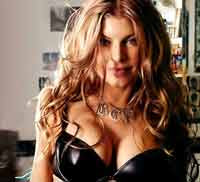
Stacy Ann Ferguson (born March 27, 1975), better known by her stage name Fergie, is an American pop and R&B singer, songwriter, and actress. She is a former member of the kids' television series Kids Incorporated, and the girl group Wild Orchid. Ann Ferguson was also a co-host of the television show Great Pretenders. She is currently a vocalist for the hip hop/pop group the Black Eyed Peas, as well as a solo artist, releasing her debut album, The Dutchess, in 2006. The album has so far spawned three US Hot 100 number ones, making Ferguson the first female solo artist to have three number ones from the same album since Christina Aguilera did so in 2000 with her debut.
In April 2007, she gave an interview in which she admitted that she went on a sex and drugs spree when she turned 18, saying: "I have had lesbian experiences in the past. I won't say how many men I've had sex with - but I am a very sexual person."
Christina Aguilera

Christina María Aguilera, born December 18, 1980, is an American pop singer and songwriter.She revealed in an interview "I love to look at naked women. I am open with my sexuality."
Billie Joe Armstrong

Billie Joe Armstrong (born February 17, 1972, in Oakland, California) is best known as the lead singer, main lyricist, and guitarist for the punk rock band Green Day. “I think I’ve always been bisexual,” Armstrong says. “I mean, it’s something that I’ve always been interested in. I think everybody kind of fantasizes about the same sex. I think people are born bisexual, and it’s just that our parents and society kind of veer us off into this feeling of Oh, I can’t. They say it’s taboo. It’s ingrained in our heads that it’s bad, when it’s not bad at all. It’s a very beautiful thing.”
Lindsay Lohan

Lindsay Dee Lohan (born July 2, 1986) is an American actress and pop music singer. Lohan started in show business as a child fashion model for magazine advertisement and television commercials. At age ten, she began her acting career in a soap opera. Lindsay chose "bi" for her orientation on her MySpace profile as well as "in a relationship" for her status selection. She is currently said to be romantically linked with Samantha Ronson, an openly gay female celebrity DJ.
Drew Barrymore

Drew Blyth Barrymore (born February 22, 1975) is an American actress and movie producer, the youngest member of the Barrymore family of American actors. She has her own production company, Flower Films. Barrymore made her screen debut in Altered States (1980). Her breakout role two years later was in E.T. the Extra-Terrestrial. She quickly became one of Hollywood's most recognized child actresses going on to establish herself in mainly comic roles. Drew says she's had numerous affairs with women and will continue to do so. "Do I like women sexually? Yes, I do. Totally," she admits. US magazine reported in 2007 Jane Pratt, the former editor of Jane magazine says she and Drew Barrymore had sex.
Although she didn't elaborate or say when this happened, Drew Barrymore was on the cover of Jane in 1997.
Drew says, "I think a woman and a woman together are beautiful, just as a man and a woman together are beautiful."
Angela Bowie

Angela Bowie, most commonly known as Angie Bowie, was born 1949 in Cyprus, as Mary Angela Barnett. She is an American citizen who has been a covergirl, model, actress, musician, groupie and, most recently, a best-selling author. She has publicly proclaimed that she is proudly and openly bisexual. Angela is also famous as ex-wife of David Bowie.
Melanie Brown

Melanie Janine Brown (born 29 May 1975), professionally known as Mel B and Melanie Brown, is an English pop singer and songwriter turned actress and television personality best known as one of the members of the girl group the Spice Girls, one of the most successful female groups of all time.
Debbie Harry

Deborah Ann Harry (born July 1, 1945, in Miami, Florida) is a Grammy-winning and Golden Globe-nominated musician most famous for being the lead singer for the punk-rock and new wave band Blondie. Following her success, she went on to moderate success as a solo artist.
In one interview, she said: "I am probably more heterosexual than I am homosexual, or even bisexual."
Nina Hartley

Nina Hartley (born Marie Louise Hartman on March 11, 1959 in Berkeley, California) is an American porn actress and sex educator.
Hartley is openly bisexual in her private life, and had what has been described as the longest stable relationship in the adult business, living in a ménage a trois with her husband Dave (whom she met when she was 19), and "wife" Bobby Lilly for 20 years.
Missy Higgins

Missy Higgins (born Melissa Morrison Higgins on August 19, 1983) is an award-winning Australian singer-songwriter, best known for her hit singles "Scar" and "The Special Two" off her debut album The Sound of White. Her second album, On a Clear Night was released in April 2007.
Higgins' sexuality has been brought into question due to the content of her lyrics and her demeanour. It is also notable that she does not use male or female pronouns to describe her partner during her concerts. She has neither denied nor confirmed any stance, although she has been quoted as saying: "I think everyone is a bit bisexual but not everyone admits it. Or not everyone has realised it yet".
Jenna Jameson

Jenna Jameson (born Jenna Marie Massoli on April 9, 1974), an American porn actress and entrepreneur.
She has stated the best relationship she ever had was her lesbian love affair with porn actress Nikki Tyler, which she documents in her autobiography. They lived together at the start of her porn career and again before her second marriage. Famous male boyfriends discussed in her autobiography include Marilyn Manson and Tommy Lee.
Angelina Jolie

Angelina Jolie (born June 4, 1975) is an American movie actress, a former fashion model, and a Goodwill Ambassador for the UN Refugee Agency. She is often cited by popular media as one of the world's most beautiful women and her off-screen life is widely reported. She has received three Golden Globe Awards, two Screen Actors Guild Awards, and an Academy Award.
Jolie has said in interviews that she is bisexual and has long acknowledged that she had a sexual relationship with her Foxfire co-star Jenny Shimizu, "I would probably have married Jenny if I hadn't married my husband. I fell in love with her the first second I saw her." In an interview with Barbara Walters in 2003, asked if she was bisexual, Jolie responded, "Of course. If I fell in love with a woman tomorrow, would I feel that it's okay to want to kiss and touch her? If I fell in love with her? Absolutely! Yes!"
Alanis Morissette

Alanis Nadine Morissette (born in Ottawa, 1 June 1974) is a Canadian and naturalized American singer-songwriter, record producer, and occasional actress. She has won twelve Juno Awards and seven Grammy Awards, and has sold more than forty million albums worldwide.
Kate Moss

Katherine Ann Moss (born January 16, 1974), known as Kate Moss, is an iconic English supermodel and fashion designer. She is known for her waifish figure and many advertising campaigns and is also notorious for her high-profile relationships and party lifestyle. She has appeared on over 300 magazine covers.
On 15 September 2005, London's Daily Mirror ran front page and inside photos that seemed to show Moss snorting several lines of cocaine at a Babyshambles recording session. It was also reported that Moss snorted five lines in 40 minutes. It has been alleged by Babyshambles' singer Pete Doherty that James Mullord, his former manager, sold the photos to the newspaper for more than L150,000. Within a short time of publication, Kate Moss lost major modeling contracts with several international companies. The story was followed up the following weekend, with the tabloids suggesting Moss had a long-standing lesbian affair with best friend Sadie Frost, having had drug fuelled sex sessions with both Frost and Sadie's then husband Jude Law several times, and that she has also been involved in lesbian threesomes with Frost and British TV star Davinia Taylor.
Martina Navratilova

Martina Navratilova (born October 18, 1956, in Prague, Czechoslovakia) is a former World No. 1 woman tennis player.
Martina's parents, especially her father, were disturbed by the knowledge of her sexual orientation, which her father characterized as a "sickness." During one of the many arguments that followed Navratilova's coming out, her father said that he would have preferred for her to have been a prostitute. Navratilova said she feared her sexual orientation might disrupt her application for American citizenship following her defection from Czechoslovakia, a country in which, she points out, "gays were sent to insane asylums and lesbians never came out of the closet." In 1981, shortly after being granted U.S. citizenship, Navratilova came out publicly about her sexual orientation. From 1983 to 1991, Navratilova had a long-term relationship with partner Judy Nelson. Their split in 1991 included a much-publicized legal wrangle. Navratilova was featured in a WITA (Women's International Tennis Association) calendar, shot by Jean Renard with her Wimbledon trophies and Nelson's children in the background.
Martina Navratilova also made a humorous guest appearance on the gay-themed NBC sitcom Will & Grace in a 2000 episode in which a flashback revealed that she had been a heterosexual until a 1985 relationship with Karen Walker turned her gay.
Pink

Born Alecia Beth Moore on September 8, 1979, known professionally as Pink (often stylized as P!nk), is an American singer-songwriter who gained prominence in 2000. As debate over gay marriage began, Pink told The Advocate: "If you want to marry Joe Millionaire, go ahead. If you're a celebrity and you want to marry your high school sweetheart for hours, go right ahead. If you're J.Lo and you want to marry 18 people for six days each, hey go right on ahead! But if you happen to be reasonably minded and have fallen in love and want to marry your soul mate and make a life of it - and you just so happen to be the same sex - then, no, how dare you! You demon creatures! We'd rather you just buy gasoline and support our war and continue to consume and fear in our country so we can make money off you. But do us a favor: Don't hold hands in public."
Lou Reed

Lewis Reed (born March 2, 1942) is an American rock singer-songwriter and guitarist. Reed first found prominence as the guitarist and principal singer-songwriter of The Velvet Underground (1965-1973).
He said once: "They put the thing down your throat so you don't swallow your tongue, and they put electrodes on your head. That's what was recommended in Rockland County to discourage homosexual feelings."
Lou Reed was in The Primitives, with musician John Cale. The Welsh Cale had recently moved to New York to study music and was playing with the composer La Monte Young's Theater of Eternal Music along with Tony Conrad. Cale and Conrad were both surprised to find that for "The Ostrich" Reed tuned each string of his guitar to the same note. This technique created a drone effect similar to that which Cale and Conrad were experimenting with in their avant garde ensemble. By contrast, according to Cale's memoirs, Reed demonstrated little interest in Cale's musical pedigree and continually propositioned him for sex.
Sex book - Best Gay Erotica 2009




